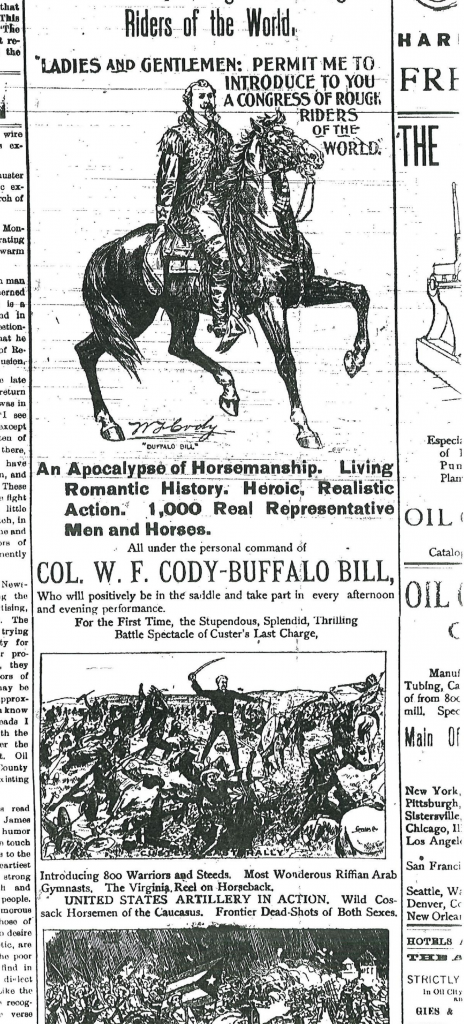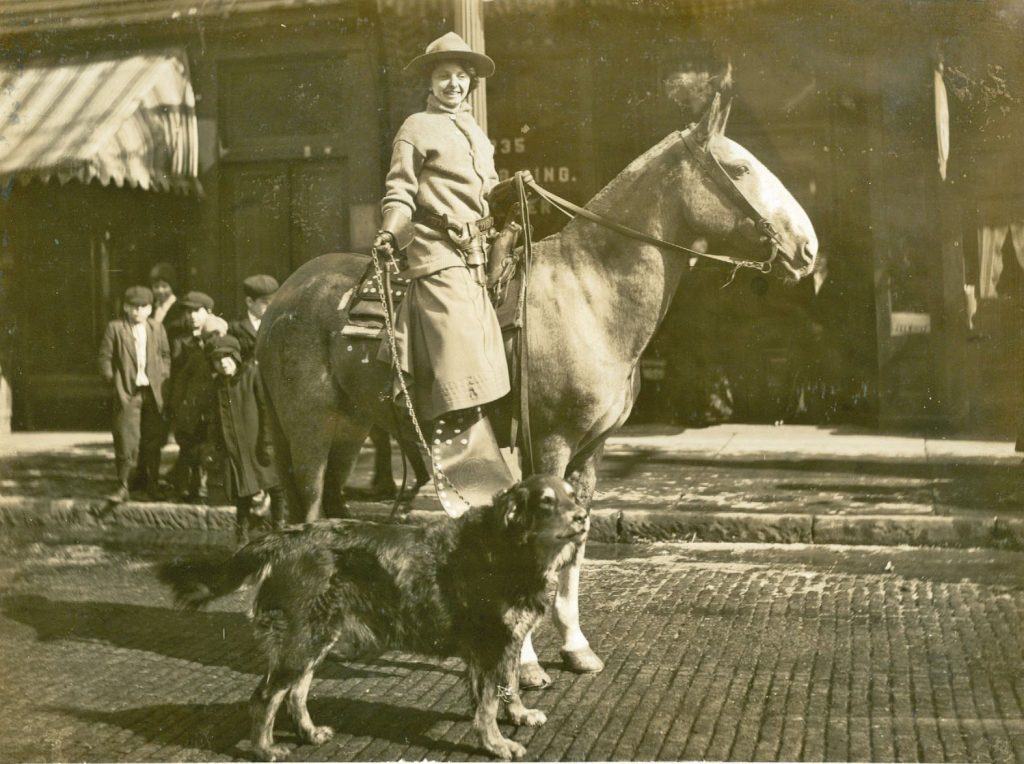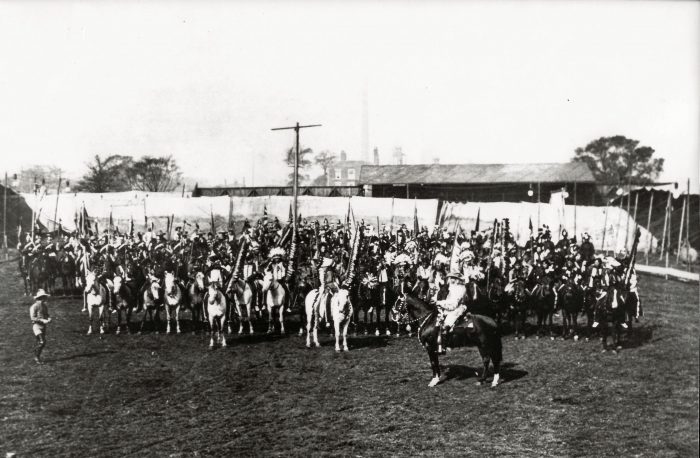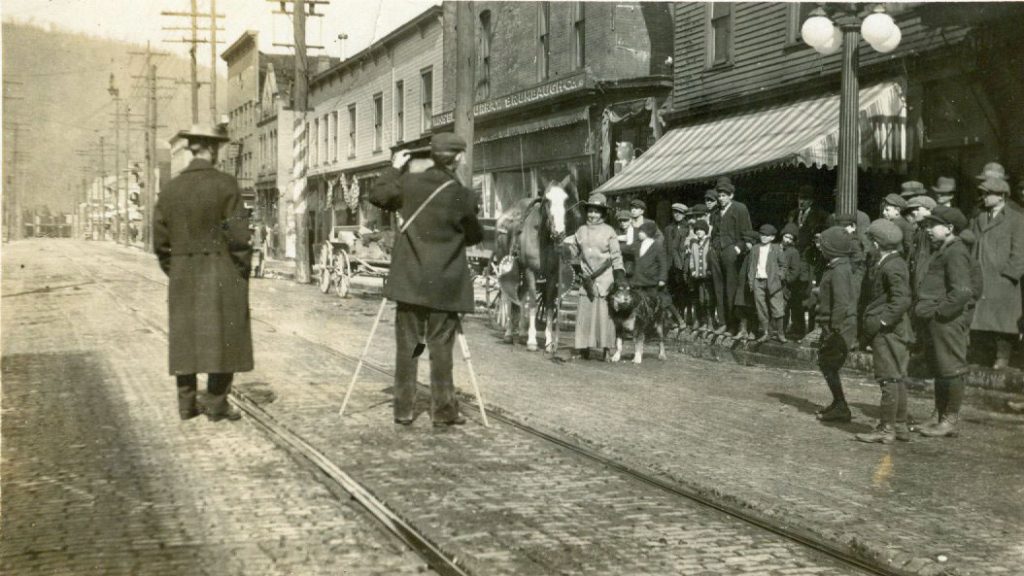Buffalo Bill
- Judy Etzel
- August 27, 2021
- Hidden Heritage
- 4310
An entertainer considered by many to be the epitome of the Wild West showman made frequent appearances in Oil City.
In his debut in the city, he was roundly criticized for swindling the audience and putting on an “atrociously poor” show. Don’t come back to Oil City, blared a local newspaper headline.
However, subsequent shows over the years in the city drew acclaim as patrons as well as the media claimed the showman offered up more in-person history than any book or travel guide could provide.
The showman was Col. W. F. Cody, more familiar to the public as Buffalo Bill. Cody first came to Oil City in January 1873 as the start of the Buffalo Bill show, sponsored by promoter Ned Buntline who was known as the King of the Dime Novelists. It was the traveling show that marked his debut.
The show was staged at the Academy of Music in Oil City, later known as the Opera House atop Center Street. The presentation, one which drew a large crowd, was vigorously panned by The Derrick and Blizzard newspapers.

The performance was “atrociously poor” and had no redeeming qualities, noted the newspaper. It ended up being only a one-night stand.
“To add to this, they perpetrated the swindle of claiming all the lower part of the house as ‘reserved’ and charging a dollar admission to all but the gallery.
“We advise these ‘Border Ruffians’ not to come to Oil City again. They may get scalped. We’ll set little Brave Furlong and Dead Bear Fry after them if they try any more of their Texas tricks around here.”
Furlong and Fry were city police officers.
Back to Oil City
However, Buffalo Bill returned to Oil City four years later when he resumed his show tour after fighting in the Indian War. Left out of the show, held at Oil City’s Opera House, was former sponsor Buntline who was replaced by Wild Bill Hickock. The 1877 circuit included Titusville where Wild Bill drew headlines. He reportedly “single-handedly, and without gunfire, dispersed a gang of oil field roughnecks who were taunting him” at the show.
A newspaper article noted Cody appeared in a new play, “The Red Right Hand” which also was named “Buffalo Bill’s First Scalp for Custer.” The play was based on the story that Cody had scalped Indian Chief Yellow Hand in the Battle of Indian Creek on July 17, 1876.
“Many of the scenes were startling,” reported the media. “… Mirth, fights and love were combined in the blood and thunder play.”
Cody returned in 1873 for a show and reportedly was so smitten with the city that he gave the mayor a pair of leather high-cuffed gloves in appreciation for the city’s reception of his show. The gloves boasted beaded decorations.
Cody came back to the city again in 1879 to appear in a presentation of “Knight of the Plains.” There was another western-style show in town at the same time and it offered marksmanship, fighting, wild animals and more.
Another visit to Oil City was in July 1901 and it was one of the grandest of affairs. “Buffalo Bill, whose name and great career is known by every man, woman and child in the Eastern and Western Hemispheres has arrived in Oil City from New Castle,” blared a headline in The Blizzard.
An Elaborate Parade
Cody’s show actually began with a huge parade down Oil City’s main street. The 10 a.m. parade, “witnessed by many thousands,” featured Cody riding in a coach, followed by a 30-piece band, “a hundred or more war-painted savage-looking Sioux chiefs and braves, Cossacks from the Caucasus, Bedouins on sleek Arabian steeds, English lancers and more. “A contingent of U.S. Cavalry and Artillery soldiers drew thunderous applause and cheers from spectators.
“The old Deadwood mail coach, made famous by the many thrilling tales written about the sensational hold-ups in Western life, was an attractive spectacle,” reported the newspaper. “…The electric light plant on wheels attracted considerable attention also.”
The newspapers ginned up interest in Buffalo Bill’s Wild West Show. Large advertisements promised “An Apocalypse of Horsemanship. Living Romantic History. …1,000 real men and horses.” The star would “positively be in the saddle and take part in every afternoon and evening performance.” And, promised the ads, the show would include “Frontier Dead-Shot of Both Sexes” with famed Annie Oakley playing her role.
“The word Rough is simply a synonym of the daring, unique and dashing horsemanship they display and the show is one worthy of the patronage of all classes of society,” insisted The Derrick. “… All veritable masters of the horse … (who) will perform feats of equestrianism impossible to copy by any imitators.”
Cody’s show was more than entertainment, insisted the media. It was also an educational show.
“The management believes, and rightfully so, that such object lessons will be far more indelibly instructive than the perusal of histories or books of travel can ever be to students of anthropology,” insisted the newspaper.
In subsequent tours across the nation, Cody advertised his Wild West Show as a farewell tour. That did occur in 1913 when his Buffalo Bill’s Wild West Show went into foreclosure because of an unpaid debt. The star then spent a few seasons with traveling circuses, including the Sells-Floto Circus that staged shows in Franklin and Oil City. His last performance in this area was with that circus in 1931.
Other Cowboys
Buffalo Bill performed both on stage and outdoors during his Wild West extravaganzas in Oil City. There were other cowboys, too, who included Oil City on their circuit visits.
Tom Mix and his horse, Tony, billed as the Wonder Horse, appeared in Oil City in 1931 with his traveling cowboy show. He gained more fame later as an early film star.
Tex Ritter, a movie star and singing cowboy, made a personal appearance on stage at the Latonia Theater in the 1940s.
The Lone Ranger and his horse, Silver, appeared on stage at the Drake Theater in the late 1950s. Silver was stabled at a farm on Grandview Road.
Hopalong Cassidy, too, was reportedly in Oil City during that same time.
Cross-Country Traveler
Alberta Clare, known as “the girl from Wyoming” and described by the press as “a diminutive pistol-gripping champion for women’s rights”, traveled solo by horse in 1912-1913 from the West Coast to New York City where she was greeted by Teddy Roosevelt. It was an 8,000 mile journey for the former Vassar student who had been suspended for her efforts to promote women’s suffrage.
Clare, accompanied by her dogs, was the featured performer in late February 1913 at The Orpheum Theater in Oil City. News reports show she regaled the audience with tales about her cross-country trip and had her dogs perform tricks.
“The most wonderful dog acts ever seen in this or any other theater” wrote a reporter, adding that her horse Duke stood patiently tethered outside the theater.
Oil City experienced a dramatic ice-fueled flood on the day Clare was in town and her photographer reportedly took numerous pictures of the flood and resulting damages.
Clare raised money for her trip expenses by selling postcards in the lobby. She was also paid by newspapers as they chronicled her cross-country trek.

Support This Project
Donations to the library are appreciated to help offset printing costs & make this project possible!
Make a DonationWritten by Judy Etzel with research by Kay Dawson and design by Natalie Cubbon.


